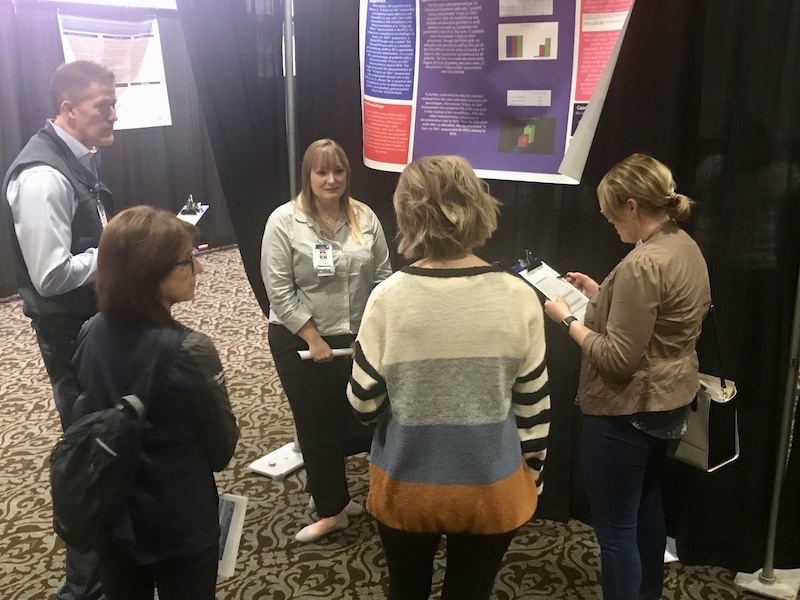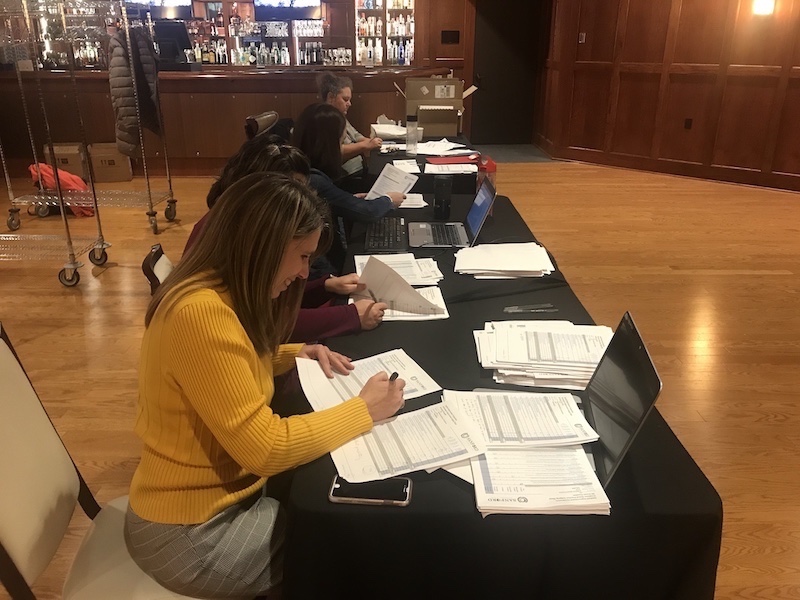Sanford Health leaders encourage innovation. So its employees are always looking for better ways to care for patients or operate more efficiently, even during a pandemic.
When COVID-19 forced the cancellation of four regional in-person quality improvement symposiums that showcase those ideas, the events went virtual using a crowdsourcing tool called Ideawake.
“They had done the work and we didn’t want to not recognize it,” said Kelly Hasvold, senior director of quality.
The symposiums entail employees submitting an abstract and poster that explains how they made some kind of quality improvement in their departments. Usually, each person or team gathers at regional events in Sioux Falls, South Dakota, Bemidji, Minnesota, or Fargo or Bismarck in North Dakota. The idea submitter gives a presentation next to their poster as judges ask questions and score it based on various criteria.

Photo by Carson Walker, Sanford Health
Bigger audience
Rather than cancel the competition altogether, the quality team moved it to the Ideawake website. And instead of meeting judges in person, each entrant produced a short video with their presentation that the judges could watch.
“It provides an opportunity to not only see the idea but to hear what the individuals are talking about. Being able to have that presentation taped lets them feel and hear more about the story,” said Whitney Edgington, quality and improvement manager for Sioux Falls.
Some judges said they did miss being able to ask questions of the submitter. But having a one-way video presentation was better than not having the symposiums at all, she said.
“Otherwise, everybody really appreciated being able to see other individual improvement projects. And not only in our market (region) but also other markets across the enterprise,” Edgington said.
Though there were a few technical glitches, mainly with the videos, the overall feedback was positive. Ideawake works on a smartphone, tablet or computer.
“The simplicity of Ideawake surprised many end-users,” said Juliana Aadland, director of quality in Sioux Falls. “Providing a simple process for judging was essential to making the virtual event successful.”
Well-timed project
One of the winning symposium projects is attracting attention beyond Sanford Health’s internal staff because it helps solve a major problem created by the pandemic.
Patients who have to take the blood thinner warfarin must have their blood tested frequently. The regimen begins as every few days when they start warfarin to about once a month once they get the dosing right. Patients usually go to their nearest hospital or clinic to have this international normalized ratio (INR) test done.
When COVID-19 hit in March, some patients were rightfully concerned about going out. And clinic staff also didn’t want to expose themselves to anyone who might be positive.
Pharmacist Michael Gulseth and the team at the Anticoagulation Management Service clinic in Sioux Falls saw it as a chance to apply a new approach that they started testing in October 2017. The idea was to teach patients how to do their own INR test and send in the results.
“It can be a major burden for people who are elderly and not able to move around very well. We also have many people in rural areas. They’re 20 to 30 miles away from the nearest clinic,” Gulseth said. “We were hit with a very, very challenging situation. We had people who were terrified of having their INR done and we didn’t want them or our staff to get sick. We made a decision to make a full court switch and tried to put as many of them on home INR testing as possible.”
The number of patients taking their own tests increased from about 300 every month to more than 450. Those people avoided roughly 4,000 trips to the lab because of the home INR testing during the pandemic so far, Gulseth said. “That’s patients not leaving their house and going to a lab facility to get tested. That is over 4,000 potential COVID-19 exposures eliminated,” he said.
Quality improvement helps patient care
Gulseth and the team won the Braithwaite Award, named for the late Sanford Health physician Dr. Thomas Braithwaite. He helped establish the anticoagulation clinic and was an advocate of always finding better ways to care for patients.
“He would have loved this (home INR testing) program because this is exactly the kind of thing he appreciated,” Gulseth said.
Hasvold, who oversees all quality efforts across the organization, said the INR testing program is a perfect example of why Sanford Health holds the quality improvement symposiums. Clinical and nonclinical employees, providers, researchers, students and other employees are in the best position to spot solutions to problems.
“We didn’t even talk about improvement when I was in nursing school. Now with virtual exposure to this work, we are creating an eye or a lens toward improvement that’s going to sustain this work and make us better,” she said.
Hasvold said the judging process had been very time consuming but is simple and fast in Ideawake. Judges’ scores are tallied automatically instead of by hand. It also gives all participants the opportunity to comment on and upvote, or like, ideas submitted by other people.
“It’s almost like Facebook,” she said. “Even though we lost the in-person symposiums, we didn’t lose the ability to get feedback and have people look at our work and provide insight into what the next step might be or how to make it sustainable moving forward.”

Photo by Carson Walker, Sanford Health
Wider implementation
Hasvold and Edgington said having all ideas consolidated in one place helps Sanford Health staff and leaders identify and implement the best ideas across the organization. “They don’t have to have been at every symposium and heard every single project,” Edgington said.
Holding the symposiums virtually also gave more staff the chance to take part in the competition because it removed distance and scheduling barriers.
“I think the virtual has to be a piece of the puzzle (in the future),” said Kelly Bartsch, improvement advisor in Bismarck. “It opens doors in Dickinson or Minot (in North Dakota) or people working shift work. It has opened doors to people who have not taken part in the past.”
Coby Skonord, founder and CEO of Ideawake, which operates in 39 countries and more than 200 cities, said the company has helped digitize offline events in the past but not on the scale of the four Sanford Health symposiums. Health systems especially are using more engaging crowdsourcing tools to tap the talent of their front-line staff to improve patient care and maximize efficiency, he said.
“Enabling asynchronous collaboration and evaluation of ideas at scale so people don’t have to be in the same room at the same time is something we’ve seen a significant increase in demand for in 2020. Based on the environment we find ourselves in today, I believe this trend is only going to accelerate,” said Skonord.
Sanford Health values the ideas and problem-solving ability of its physicians, researchers, clinical workers and support staff. Any employee with an idea for a device, therapy, software, tool or other method that helps patients is encouraged to contact the commercialization team and join the dozens of people at Sanford Health who are already inventing.
Learn more
- Clinics share best pandemic ideas on new crowdsourcing tool
- How an internal education program is improving patient care
- Podcast: ‘Innovation happens all over the place’
…
Posted In COVID-19, Innovations, Leadership in Health Care, Physicians and APPs, Sanford Stories, Wellness
